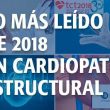Fractional Flow reserve (FFR) guided myocardial revascularization surgery (CABG) has similar graft failure rate and clinical outcomes as angiography guided CABG. When planning PCI, the value of FFR for lesion assessment pose no questions, but we know little when it comes to CABG. Since the early start, back when Dr. Mason Sones performed catheterizations and...
ACC 2019 | TAVR in Low-Risk Patients Is Noninferior
Courtesy of Dr. Carlos Fava. Self-expanding supraannular aortic valves have proved to be superior to surgery in high-risk patients and noninferior in intermediate-risk patients. However, the current challenge is posed by low-risk, generally younger, patients. In that sense, our purpose is to determine device effectiveness and safety in terms of mortality and stroke rates (which are...
Transcarotid Approach for Transfemoral in TAVR
Courtesy of Dr. Carlos Fava. At present, the transfemoral is the preferred access site in TAVR, for it has been shown to present fewer complications. However, whenever not feasible, we can resort to other approaches. These include the subclavian, the transapical, the transcaval, the transaortic, and the transcarotid. This last one has been studied few...
NOTION and UK TAVI Report Good Long-Term Outcomes
Both studies followed beyond 5 years patients with severe aortic stenosis who had undergone transcatheter aortic valve replacement (TAVR). Findings included low rates of significant valve degeneration and failure, in both cases. While data on the long-term degeneration of transcatheter-implanted valves are scarce, follow-up from the NOTION trial of low-risk patients and from the UK TAVI...
The Most Important Articles of 2018 in Structural Heart Diseases
1- ESC 2018 | MITRA FR: Testing MitraClip for Secondary Mitral Regurgitation In secondary mitral regurgitation, mitral-valve leaflets and chordae are structurally normal and mitral regurgitation results from alterations in left ventricular geometry and function. Read more 2- TCT 2018 | COAPT: MitraClip in Patients with Secondary Mitral Regurgitation The prognosis of patients with...
Balloon-Expandable vs. Self-Expanding: To Each Valve Its Own Annulus
The former generation of valves, the balloon expandable (Sapien XT), was associated to less paravalvular leak than the self-expanding valves only in patients with larger annuli. The new generation of self-expanding valves (Evolut R) has managed to significantly improve sealing in patients with larger annuli and still holds potential benefits for smaller annuli. The aim...
Clinical Improvement Without Ventricular Function Improvement After CTO
The benefits offered to patients by attempting the rechanneling of a chronic total occlusion are still unclear. Additionally, sometimes the procedural risks are somewhat undetermined. Taking into account these controversies, this work sought to prove whether successful rechanneling of a chronic total occlusion improves ventricular function. This is not a soft endpoint; it has been...
Ambulatory Continuous Monitoring in Patients with Left Bundle Branch Block After TAVI
The incidence of arrhythmic events up to a year after implantation is high and involves almost half the patients with complete left bundle branch block following the procedure. Significant bradyarrhythmias occur in up to one-fifth of the patients, half of whom ultimately require a pacemaker. These data support the idea of a cardiac monitoring device...
TCT 2018 | SOLVE-TAVI: Self-Expandable vs. Balloon-Expandable Valves and General vs. Local Anesthesia in One Study
This prospective, randomized, multicenter study included 447 patients with severe aortic stenosis and intermediate or high surgical risk randomized in a 2×2 factorial design to general vs. conscious sedation with local anesthesia and also to receiving the Sapien 3 valve (balloon-expandable) vs. CoreValve Evolut R (self-expandable). Primary end point was a composite of all-cause mortality,...
Post-Dilation in Valve-in-Valve Implantation Offers Hemodynamic Improvement
Courtesy of Dr. Carlos Fava. A significant number of patients present severe aortic stenosis and undergo surgery with 19-to-21-mm bioprostheses. These patients frequently evolve with high gradients and receive Valve-in-Valve (ViV) implantation. In about a third of patients with high post-procedural gradient (≥20 mmHg), this has been associated with poor outcomes. This study analyzed 30 patients who underwent...









